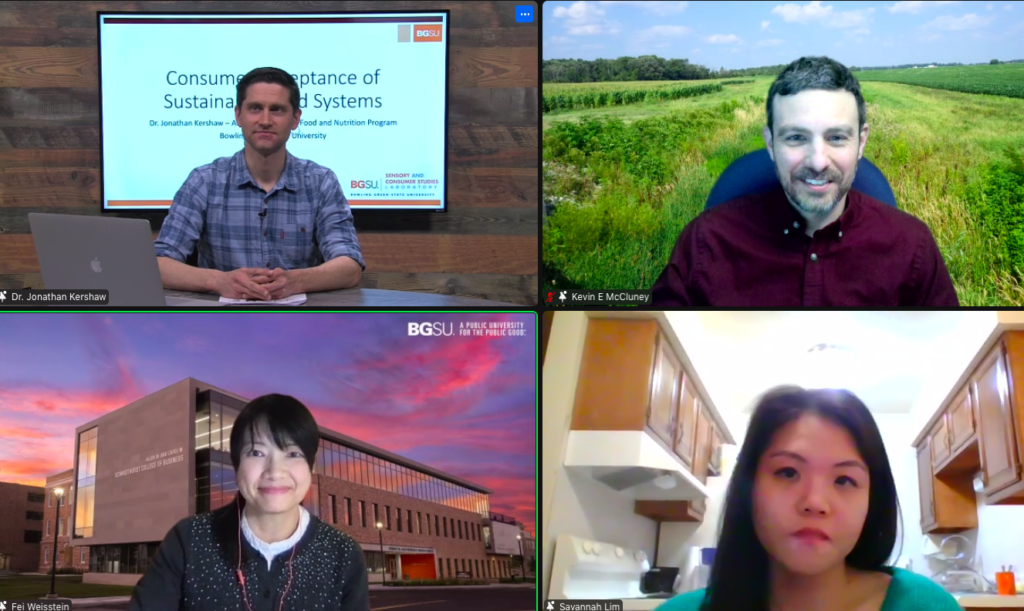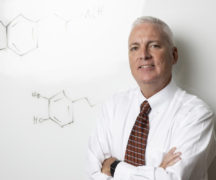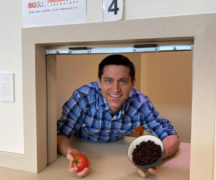By DAVID DUPONT
BG Independent News
Telling consumers about the environmental or health benefits of food can make them more inclined to purchase them. But whether they will or not is more uncertain.
Food choice is complex, Jonathan Kershaw, an assistant professor in food and nutrition, told last month’s virtual Science Café. [Click to view.] Working with colleagues including Fei Weisstein, associate professor of marketing, Savannah Lim, a registered dietician who recently received her master’s degree in and food nutrition, Kershaw studied how consumers react to sustainable food.
Sustainable means many things to many people – low carbon footprint, environmentally friendly, responsibly sourced, economically viable, non-toxic – were some of the attributes suggested by those attending the virtual event.
What shoppers buy is affected by a plethora of factors – taste, affordability, accessibility, health concerns, and environmental awareness.

“We need to find out what really triggers you to consume,” Kershaw said.
Weisstein said those decisions are often spur of the moment when the shopper is in the grocery store. And just because consumers think one benefit is important, doesn’t mean they view it as the most important.
Kershaw looked at how messaging can influence consumer behavior around three products: fish grown in an aquaponic system like the one at BGSU; plant-based protein; and Kernza, a perennial wheatgrass.
In blind taste tests, Kershaw noted, consumers really did not distinguish whether wild caught, farm-raised or aquaponic fish tasted better.
However when told which was which, wild caught was deemed to taste better than the other two. Aquaponic-raised fish, Kershaw said, were seen as comparable to farm-raised fish which consumers consider less tasty and less nutritious.
However, when informed of the environmental detriments and benefits of the three ways of procuring fish, that changed.
The problem with wild caught fish, Kershaw noted, is the depletion of natural fisheries. Farmed fish in open pens in the ocean has also been associated with damage to habitat.
Aquaponics uses a closed system to raise perch with the waste from the fish used to grow a crop, tomatoes in the case of BGSU’s project. The system also cultivates fresh-water prawns.
[RELATED: Aquaculture provides food for thought at BGSU Science Café]
When informed of the environmental benefits of aquaponics, consumers then considered them tastier and more nutritious.
When it comes to meat compared to plant protein, consumers believe meat based protein has more favor, and they are also less familiar with vegetarian alternatives. (The study did not address plant-based meat-like products such as Beyond Meat.)
Meat takes more resources and contributes more to greenhouse gases than plant based proteins with beef tending to contribute most to greenhouse emissions. However, Kershaw noted, there is a wide range of impact depending on how a particular food is grown, and that range is particularly large with beef.
Kershaw and Lim developed an eight-week text intervention where subjects were sent messages touting the benefits plant-based protein. One group received messages about the health benefits and another received messages about the environmental benefits.
The researchers asked the subjects what they ate before they started receiving the messages and what they ate afterward.
Following the experiment, the subjects when shown photos of meat or plant-based protein tended to rate the plant products as more appealing. However, their diets did not change.
The third study looked at consumer acceptance of a newcomer on the food scene, Kernza, an intermediate wheat grass that does not have to be planted every year.
Kernza, Kershaw explained, has a deep and large root system. Those roots help keep soil in place, absorb more carbon, foster a healthy biome, and reduce water pollution.
The ongoing study is considering whether it matters more if the message focuses on something being better for the environment or better for personal health.
The problem, Kershaw said, is that something benefiting the environment does not have an immediate, observable effect.
Also, the study is looking at whether the type of product matters. Would consumers be more willing to purchase a treat like a brownie made from Kernza or something more useful like granola?
Kershaw also said he’s doing a study with undergraduates looking at food choices in dining halls. That study is showing that concern about animal welfare has more of an impact on food consumption than either health or environmental benefits.
For those wanting to eat a more sustainable diet, he had a few recommendations.
Making small, incremental changes in conjunction with other environmental behaviors can be beneficial.
And when incorporating new foods, find foods that are appealing. “If you don’t like the food, you probably won’t eat it.”
[RELATED: Check out the next Science Café tonight (March 29) on how technology is changing everyday life]





